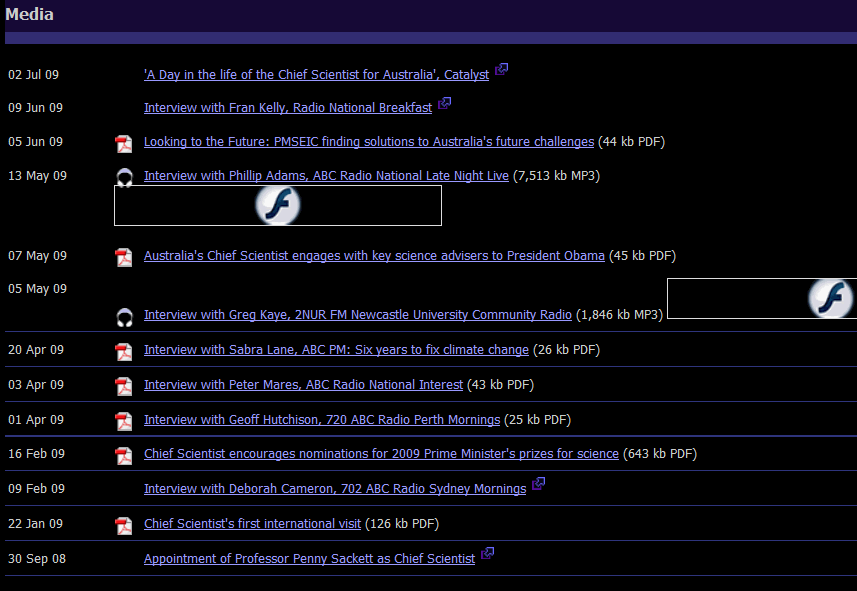Professor Penny Sackett took her PhD in theoretical physics from the University of Pittsburgh. She was appointed Director of the ANU Research School of Astronomy and Astrophysics and Mount Stromlo and Siding Spring Observatories in 2002. At the request of the Australian Government on November 3, 2008 she assumed the role of Chief Scientist for Australia. She does, however, retain academic status at the ANU to enable her to continue to mentor students. Professor Sackett's personal research interests include dark matter, galactic structure, and extrasolar planets.
In her speech accepting her appointment as Chief Scientist she emphasised: The title of my new post is Chief Scientist for Australia, not Chief Scientist of Australia. And so I will have many hats to wear, as a commissioner of expert studies, facilitator for innovation, a bellwether for the nation's most important scientific issues, a communicator and an ambassador and, perhaps most importantly, the Chief Scientist must be a strong and continuous advocate of evidence-based decision making.
Now just over ten months on the job, which was made fulltime by the Rudd government, just what can Professor Sackett list as her accomplishments with regard to her advocacy for the many hats she wears?
Truth to tell, we really don't know. Here is the complete listing of media releases on the Chief Scientist's Home Page:

Apart from any other considerations as you can see, nothing has been added for almost 2½ months.
On June 5, 2009 the Prime Minister's Scientific, Engineering and Innovation Council met with the purpose of:
LOOKING TO THE FUTURE:
PMSEIC FINDING SOLUTIONS TO AUSTRALIA’S FUTURE CHALLENGES
The Prime Minister’s Science, Engineering and Innovation Council (PMSEIC) met today to discuss how innovation, science and research can contribute to ensuring Australia is prepared for the challenges and opportunities of the future, which will involve new approaches to knowledge generation, health, sustainability, and economic and social development.
When TFW asked a member of the Chief Scientist's staff how many of the 11 ministerial members of PMSEIC were actually present, we were told that the staffer was not in a position to answer (we still don't know):
The ministerial members' of PMSEIC?
TFW has on several occasions in the past opined that not until PMSEIC and the Office of the Chief Scientist are transferred to the Department of The Prime Minister and Cabinet can Professor Sackett's goal of a broad vision and cross-portfolio co-operation be taken seriously. That is the minimum requirement for demonstrating that PMSEIC's standing committee and the Chief Scientist are indulging in anything more than a talking shop, or that the Prime Minister takes the opportunity to consult the Chief Scientist when it's sensible to do so.
Last week we sent the following email to Professor Sackett:
Dear Professor Sackett,
On September 2 the presidential science advisor, John Holdren was
one of the guests on David Letterman's -Late Show-.
At one point Mr Letterman asked Professor Holdren how often he talked
with the president, Holdren answered candidly, "sometimes a
couple of times a week, sometimes not for a few weeks," adding that
"it's catch as catch can."
How often do you talk with Prime Minister Rudd and may I quote your
answer on TFW?
This is the reply from a member of the Chief Scientist's staff:
Thank you for your enquiry. Professor Sackett meets
with the Prime
Minister as often as is necessary. This may be in her capacity as the
Executive Officer of the Prime Minister's Science, Engineering and
Innovation Council (PMSEIC) or in order to provide detailed scientific
advice.
All things considered it doesn't seem inappropriate to note that Professor Holdren's immediate predecessor (chief scientific advisor to President George W. Bush) John Marburger agreed that the new [PCAST] council "has a great membership and outstanding co-chairs," however, he added, perhaps ruefully, "but its ability to influence events depends on who listens."
Alex Reisner
The Funneled Web